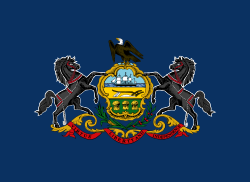History
The regiment was organized at Philadelphia, Pennsylvania, by the consolidation of Robert's Battalion Pennsylvania Heavy Artillery (redesignated Companies C, D, and F), Segebarth's Battalion Marine Artillery (Companies A, B, G, H, K, and L), and the 1st Battalion Pennsylvania Heavy Artillery (Company E). Companies I and M were organized in Philadelphia. Recruiting finished on February 17, 1863, with Joseph Roberts as colonel, R. V. W. Howard as lieutenant colonel, and John A. Darling as major.
The regiment was sent to Fort Monroe in Virginia, except for Company H, which was sent to Baltimore, Maryland. During the Suffolk Campaign, companies A, B, F, and G were sent to Suffolk and participated in the siege. During the Gettysburg campaign, Company H was assigned to the Second Division of the Army of the Potomac's Cavalry Corps and was present at the Battle of Gettysburg on July 2 and 3 1863. It fought at the East Cavalry Battlefield on July 3. After the campaign, the company returned to Baltimore, where it remained for the remainder of the war.
In the spring of 1864, the regiment was above its authorized strength, so its surplus men were organized into the 188th Pennsylvania Infantry. Shortly afterwards, it received more recruits, so it remained above strength.
During the Siege of Petersburg, Companies D, E, G, and N were assigned to the Army of the James to serve in light artillery batteries and to work on various parts of the fortifications. Detachments from various companies were assigned to the Naval Brigade, which fought along the rivers around Richmond and Petersburg during 1864 and 1865. Company I was selected as the guard company for the headquarters of the Army of the James.
Following the capture of Richmond, the regiment was reassigned to Fort Monroe, where it provided the guard for Jefferson Davis' imprisonment there. Companies A and B were mustered out at Fort Monroe on July 11, 1865; company H was mustered out at Baltimore on July 25; and the remaining companies were mustered out at Fort Monroe on November 9.
This page is based on this
Wikipedia article Text is available under the
CC BY-SA 4.0 license; additional terms may apply.
Images, videos and audio are available under their respective licenses.
